Xochimilco Light Rail
The Xochimilco Light Rail (locally known as el Tren Ligero and known by the government as Tren ligero de la Ciudad de México) is a light rail line that serves the southern part of Mexico City. It connects to, but is not considered a part of, the Mexico City Metro. Rather, it is operated by the Servicio de Transportes Eléctricos (STE), the authority that operates Mexico City's electric trolleybus system and formerly operated the municipal electric tram system.
| Xochimilco Light Rail | |||||||||||||||||||||||||||||||||||||||||||||||||||||||||||||||||||||||||||||||||||||||||||||||||||||||||||||||||||||||||||||||||||||||||||||||||||||||||
|---|---|---|---|---|---|---|---|---|---|---|---|---|---|---|---|---|---|---|---|---|---|---|---|---|---|---|---|---|---|---|---|---|---|---|---|---|---|---|---|---|---|---|---|---|---|---|---|---|---|---|---|---|---|---|---|---|---|---|---|---|---|---|---|---|---|---|---|---|---|---|---|---|---|---|---|---|---|---|---|---|---|---|---|---|---|---|---|---|---|---|---|---|---|---|---|---|---|---|---|---|---|---|---|---|---|---|---|---|---|---|---|---|---|---|---|---|---|---|---|---|---|---|---|---|---|---|---|---|---|---|---|---|---|---|---|---|---|---|---|---|---|---|---|---|---|---|---|---|---|---|---|---|---|
| Overview | |||||||||||||||||||||||||||||||||||||||||||||||||||||||||||||||||||||||||||||||||||||||||||||||||||||||||||||||||||||||||||||||||||||||||||||||||||||||||
| Type | Light rail | ||||||||||||||||||||||||||||||||||||||||||||||||||||||||||||||||||||||||||||||||||||||||||||||||||||||||||||||||||||||||||||||||||||||||||||||||||||||||
| Status | In service | ||||||||||||||||||||||||||||||||||||||||||||||||||||||||||||||||||||||||||||||||||||||||||||||||||||||||||||||||||||||||||||||||||||||||||||||||||||||||
| Locale | Mexico City | ||||||||||||||||||||||||||||||||||||||||||||||||||||||||||||||||||||||||||||||||||||||||||||||||||||||||||||||||||||||||||||||||||||||||||||||||||||||||
| Termini | Tasqueña Xochimilco | ||||||||||||||||||||||||||||||||||||||||||||||||||||||||||||||||||||||||||||||||||||||||||||||||||||||||||||||||||||||||||||||||||||||||||||||||||||||||
| Stations | 18[1] | ||||||||||||||||||||||||||||||||||||||||||||||||||||||||||||||||||||||||||||||||||||||||||||||||||||||||||||||||||||||||||||||||||||||||||||||||||||||||
| Ridership | 21 million per year (2007)[2] | ||||||||||||||||||||||||||||||||||||||||||||||||||||||||||||||||||||||||||||||||||||||||||||||||||||||||||||||||||||||||||||||||||||||||||||||||||||||||
| Website | Tren Ligero | ||||||||||||||||||||||||||||||||||||||||||||||||||||||||||||||||||||||||||||||||||||||||||||||||||||||||||||||||||||||||||||||||||||||||||||||||||||||||
| Operation | |||||||||||||||||||||||||||||||||||||||||||||||||||||||||||||||||||||||||||||||||||||||||||||||||||||||||||||||||||||||||||||||||||||||||||||||||||||||||
| Opened | 1986 (reopening after upgrading from streetcar line) | ||||||||||||||||||||||||||||||||||||||||||||||||||||||||||||||||||||||||||||||||||||||||||||||||||||||||||||||||||||||||||||||||||||||||||||||||||||||||
| Owner | Servicio de Transportes Eléctricos del D.F. | ||||||||||||||||||||||||||||||||||||||||||||||||||||||||||||||||||||||||||||||||||||||||||||||||||||||||||||||||||||||||||||||||||||||||||||||||||||||||
| Rolling stock | 24 articulated light rail cars[3][4] | ||||||||||||||||||||||||||||||||||||||||||||||||||||||||||||||||||||||||||||||||||||||||||||||||||||||||||||||||||||||||||||||||||||||||||||||||||||||||
| Technical | |||||||||||||||||||||||||||||||||||||||||||||||||||||||||||||||||||||||||||||||||||||||||||||||||||||||||||||||||||||||||||||||||||||||||||||||||||||||||
| Line length | 12.8 km (8.0 mi)[2] | ||||||||||||||||||||||||||||||||||||||||||||||||||||||||||||||||||||||||||||||||||||||||||||||||||||||||||||||||||||||||||||||||||||||||||||||||||||||||
| Track gauge | 1,435 mm (4 ft 8 1⁄2 in) standard gauge | ||||||||||||||||||||||||||||||||||||||||||||||||||||||||||||||||||||||||||||||||||||||||||||||||||||||||||||||||||||||||||||||||||||||||||||||||||||||||
| Minimum radius | 30 metres (98 ft)[2] | ||||||||||||||||||||||||||||||||||||||||||||||||||||||||||||||||||||||||||||||||||||||||||||||||||||||||||||||||||||||||||||||||||||||||||||||||||||||||
| Electrification | 750 V DC, overhead catenary[2] | ||||||||||||||||||||||||||||||||||||||||||||||||||||||||||||||||||||||||||||||||||||||||||||||||||||||||||||||||||||||||||||||||||||||||||||||||||||||||
| |||||||||||||||||||||||||||||||||||||||||||||||||||||||||||||||||||||||||||||||||||||||||||||||||||||||||||||||||||||||||||||||||||||||||||||||||||||||||
History
Many of Mexico City's original tram lines were abandoned in the 1960s and 1970s. The original Xochimilco tramline had been in operation since 1910, but the Xochimilco tramway's section between Avenida Tasqueña and the city centre was replaced by a new metro line in 1970.[5][6] With the subsequent Mexico City tramway closures that took effect in May 1979, the only tramlines left in operation were routes 53 and 54, running from Tasqueña metro station to Tlalpan and Xochimilco, respectively.[7] These shared a common routing between Tasqueña and Huipulco, with the Tlalpan service branching off of the main line for only about 2 kilometres (1.2 mi) to its terminus at Avenida San Fernando, in the historic centre of Tlalpan borough. On the common section, the tracks were located in the wide median of Calzada de Tlalpan. The tracks between Huipulco and Xochimilco were also in a separate right-of-way. The separation from street traffic, except at crossings, made routes 53 and 54 more like what later came to be called light rail unlike Mexico City's other tramlines which were closed by 1979, but these lines still lacked other light-rail attributes such a full stations. Thus the decision was made in the early 1980s to convert these lines to modern light rail transit.
Both lines ceased operation in September 1984, for rebuilding as light rail. Changes to allow faster operation included replacing the simple tram stops with semi-enclosed estaciones (stations), which were spaced farther apart, fitted with high-level boarding platforms and set up as paid areas, so that all payment of fares would take place before boarding. In between the stations the work included installing new tracks set in concrete; putting fencing along the line's right-of-way and closing some street crossings; and installing overhead catenary designed for higher speeds.[6][8] The fleet of 1940s PCC streetcars was also replaced by a fleet of new articulated light rail cars built partially using components from the old cars, including their PCC bogies (trucks) and propulsion systems (see Rolling stock, below, for more details).[6][9]
The 5.5-kilometre (3.4 mi) section between Tasqueña and Estadio Azteca (Aztec Stadium), just short of Huipulco junction (for the branch to Tlalpan), opened as light rail on 1 August 1986, but ran for only three days before poor reliability with the heavily rebuilt rail cars led to a decision to suspend service.[8][9] Service resumed in November 1986.[9] Right-of-way work then shifted to the line's outer section, between Estadio Azteca and Xochimilco, with similar upgrading for higher-speed operation. This section opened on 29 November 1988.[9] The old tram line 54 had included a long loop through the historic centre of Xochimilco, along narrow city streets, but this was not included in the upgrading to light rail, and was permanently abandoned when closed in 1984.[6]
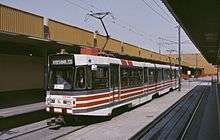
The 1.7-kilometre (1.1 mi) branch from Huipulco junction to Tlalpan was also rebuilt, but in a different manner, changed from private right-of-way to street running (without separation from other traffic) in the middle lanes of Calle Ferrocarril (now known as Renato Leduc) and also shortened by about 125 metres (410 ft) at its outer end, no longer reaching Avenida San Fernando. Three high-platform stops were built, one being at the new terminus, which was referred to simply as "Tlalpan" on the rail cars' destination signs. Service to Tlalpan was reintroduced on 13 March 1990, now running only as a one-car shuttle to and from Estadio Azteca, no longer through to Tasqueña.[10] Patronage was low, and service was discontinued only one year later, in March 1991, after an accident damaged the one car (No. 000) normally assigned to the Tlalpan route.[6] Service was reinstated on 13 December 1991, as STE began to place new cars into service on the Xochimilco line, but ceased again on 6 October 1992[6] and has never resumed.
The overhead line voltage was 600 volts DC until around the end of 1995, when it was raised to 750 V.[11]
Route
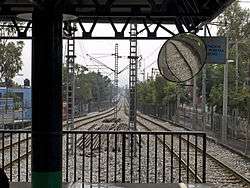
The line runs between Metro Tasqueña and the town of Xochimilco, south of Mexico City. It serves the Coyoacán, Tlalpan, and Xochimilco boroughs, giving residents a fast link to the urban south of Mexico City. For the northern stretch of its run, it travels along the central reservation of the Calzada de Tlalpan, as does Metro Line 2 south of Metro San Antonio Abad – for this reason, it is sometimes seen as a continuation of that line, albeit on a more modest scale. The light rail line has 18 stations: two terminals and 16 intermediate stations. Three of these stations were built later than the others; Huipulco, Periférico and Huichapan stations opened in November 1993.[6] The travel time from one end of the line to the other is approximately 37 minutes.
Until 1995, the outer terminus was located just beyond Calle Francisco Goitia, at what is now named Francisco Goitia station; it was named "Xochimilco" station originally. In that year, the line was extended east by about 800 metres (875 yd) to a new terminus at the western edge of Delegación Xochimilco's centre, along a section of former tram line 54, closed in 1984. This new section was opened on 14 September 1995, and the new terminus was named Embarcadero.[11] However, as the new terminus was now located closer to the centre of Xochimilco than was the actual station bearing that name, STE eventually renamed Embarcadero station as "Xochimilco", and the original "Xochimilco" station—now the line's penultimate station—became Francisco Goitia station. However, the partly single-track segment from Francisco Goitia to Xochimilco limited capacity on the line, and so the Xochimilco station was rebuilt 200 metres (219 yd) to the west and equipped with two tracks and three loading platforms. The old Xochimilco station closed in November 2007 for the start of construction, and the new station opened on 14 December 2008.[12]
Rolling stock
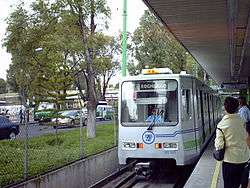
The Xochimilco line's rolling stock currently consists of 24[3] articulated light rail vehicles (LRVs) built by Concarril or Bombardier/Siemens, between 1990 and 2014. Each car is about 29 metres (95 ft) long and capable of carrying up to 300 passengers.[13] The first 16 of these replaced older cars over the period 1991–95.
The line's original fleet consisted of semi-new articulated LRVs built by Moyada (Motores y Adaptaciones Automotrices, S.A.), incorporating the bogies (trucks) and some other parts from STE's large fleet of withdrawn 1940s-vintage PCC streetcars.[5] (STE originally intended to rebuild about 20 PCCs for the lines, a project well underway at STE's Tetepilco Depot when the workshop building collapsed during the 1985 Mexico City earthquake, crushing the cars.).[14] The prototype LRV was numbered 000, and the remainder 001-016. The Moyada cars had all-new bodies and were equipped with pantographs instead of trolley poles to collect current from the overhead wires. Unlike the old streetcars/trams, they were also bi-directional, having operating cabs at both ends and doors on both sides. Perhaps because of their vintage running gear or electrical components,[9] these cars were found to be unreliable, even after the refurbishment of six in 1989–91.[6]
In 1989, STE placed an order with Concarril for 12 all-new LRVs with similar capacity, to the same design as LRVs Concarril had recently supplied to Guadalajara's light rail system. Numbered 017–028, the order's first cars arrived in January 1991 entered service on 6 December 1991,[6] replacing all of the Moyada cars except on the Tlalpan shuttle service. When Tlalpan service was withdrawn again in October 1992, the Moyada cars were no longer used. However, in 1992–93 three Moyada cars (005, 010 and 016) were again fitted with all-new bodies, now to a design intended to resemble the Concarril cars, this work being undertaken by local firm Sintra S.A.[6] The three "Sintra" cars, as they were known, the fleet's last to use PCC-type control systems, entered service on 1 June 1993.[15] They were withdrawn in late 1995, and shortly afterward the voltage of the line was raised from 600 V DC to 750 V.[11] The newer cars had already been able to operate at the higher voltage.
Four additional LRVs of the same type as the Concarril units were purchased later, in 1995, numbered 029–032. These were built by Bombardier, which had acquired Concarril in 1992,[16] but were built in the same factory (in Ciudad Sahagún) and were nearly identical to STE's 12 Concarril cars. In the mid-2000s, four more cars were purchased later from Bombardier, numbered 033–036, and they entered service on the Xochimilco light rail line in September and October 2008, increasing the fleet size to 20 cars, numbered 017–036.[12]
On 30 August 2011, on its way to Huichapan station, car 031 was hit, while coming to a stop, at full speed by car 027. Twenty-nine people were injured. The two LRVs sustained heavy damage. One half of each two-section LRV was scrapped, and in 2013 STE hired Bombardier to supply two all-new half-car sections and to combine them with the undamaged halves of the two LRVs.[3] Cars 027 and 031 both returned to service in autumn 2014.[4]
Meanwhile, another four new LRVs were purchased from Bombardier in 2013–14, which would be assigned STE fleet numbers 037–040.[3] They were delivered in summer 2014 and entered service on 16 March 2015,[4] increasing the size of the fleet to 24 cars (numbered 017–040).
Stations
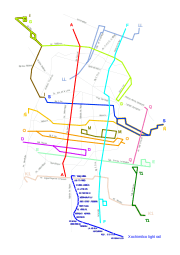
- Tasqueña – Terminal. Connects with Metro Line 2 and the city's southern intercity bus station, which serves cities like Acapulco, Cuernavaca, and the entire Republic south of the capital. Its logo is an eclipsing moon / crescent moon.
- Las Torres – Station. Its name comes from Avenida Las Torres ("The Towers"). Its logo is a picture of two high-voltage pylons.
- Ciudad Jardín – Station. Its name is given from nearby residential estate with same name. (Ciudad Jardín means Garden City). Its logo is the shape of an apartment block.
- La Virgen – Station. Its name is given from nearby Calzada de La Virgen ("Virgin Avenue"). Its logo is a stylised depiction of the Virgin of Guadalupe.
- Xotepingo – Station. Its logo is a tree.
- Nezahualpilli – Station. Its logo is Nezahualpilli's head. Near the station is Mexico City's automobile museum.
- Registro Federal – Station. Its name is given from nearby former offices of the federal automobile registration department. Its logo is the front of a car.
- Textitlán – Station. Its logo is a plant like a maguey or agave.
- El Vergel – Station. Its name is given from El Vergel neighbourhood, near the station. Its logo is a grapevine (vergel means grapevine).
- Estadio Azteca – Switching station and repair workshops for the light rail line. The station stands across from the Aztec Stadium sports arena, and its logo is a side view of the stadium. This was also the starting point of the service to Tlalpan, along Calle Ferrocarril (Renato Leduc), which opened as light rail in 1990 (having closed as tram line 53 in 1984) but ran for only one year and then later for another ten months before closing for good in October 1992.[6] Some tracks are still visible (others are buried under asphalt), and the platforms of the stations still remain.
- Huipulco – Station. Named after the nearby district of Huipulco. Its logo is a pre-Hispanic glyph.
- Xomali – Station. Its logo is the shape of something like a flower.
- Periférico – Station. Its name comes from the city's nearby outer ring-road—Anillo Periférico—(nearby are the facilities of the Tecnológico de Monterrey private university). The station's logo depicts a road junction.
- Tepepan – Station. Its name is given from a hill and a town with the same name. There was once a tramway destiny. One of the best (and last) pulquerías of Mexico City, "Nomás no llores", is near. Its logo is the Aztec representation for a hill.
- La Noria – Station. Its name comes from the zone where the station is. Noria means water well; its logo shows a well.
- Huichapan – Station. Its logo is a river with trees at its sides.
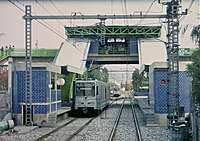
- Francisco Goitia – Station. Its name is given from a street and a zone nearby. Francisco Goitia was a painter. The station's logo is an artist's palette. From the opening of the Tren Ligero between Estadio Azteca and Xochimilco, in 1988, until September 1995, this was the line's terminus and was named "Xochimilco" station. For several years afterward, some tourist maps and media were still being published with the former name.
- Xochimilco (current station opened in 2008) – Terminal. Named after the town of Xochimilco, famous for its boat rides in boats called trajineras. Also, for the wide river zone, where so many representatives of the different flora and fauna that once existed throughout the Valley of Mexico can be found. The terminal's logo is the ancient glyph for Xochimilco. From 1995 until November 2007, this station was located about 200 m to the east, and was initially named Embarcadero.
See also
- Light rail in North America
- List of rapid transit systems
- Transportation in Mexico City
References
- "Servicios. - Servicio de Transportes Eléctricos del D.F." [Electrical transport service of the Federal District] (in Spanish). Servicio de Transportes Eléctricos del Distrito Federal. Archived from the original on July 16, 2012. Retrieved 2013-07-07.
- Webb, Mary (ed.) (2009). Jane's Urban Transport Systems 2009-2010. p. 242. Coulsdon, Surrey (UK): Jane's Information Group. ISBN 978-0-7106-2903-6.
- Tramways & Urban Transit magazine, September 2014, p. 399. LRTA Publishing (UK). ISSN 1460-8324.
- Tramways & Urban Transit magazine, May 2015, p. 207. LRTA Publishing (UK). ISSN 1460-8324.
- Morrison, Allen (2003). The Tramways of Mexico City, Part 4. Retrieved 2010-05-05.
- May, Jack (1994). "Mexico Says Sí to LRT: Light Rail South of the Border". 1994 Light Rail Annual & User's Guide, pp. 2–5. Pasadena, CA (US): Pentrex. ISSN 0160-6913.
- Modern Tramway, October 1979 issue, p. 364. UK: Ian Allan Publishing. ISSN 0144-1655.
- Saitta, Joseph P. (1987). "Down Mexico Way". Traction Yearbook '87, pp. 119–123. ISSN 0730-5400.
- "LRT Developments in Mexico". Mass Transit magazine, June 1989, pp. 20–21. Cygnus Publishing. ISSN 0364-3484.
- Modern Tramway, July 1990 issue, p. 244. UK: Ian Allan Publishing. ISSN 0144-1655.
- Webb, Mary; and Pattison, Tony (Eds.) (2003). Jane's Urban Transport Systems 2003-2004, p. 244. Coulsdon, Surrey (UK): Jane's Information Group. ISBN 0-7106-2565-0.
- "Worldwide Review [regular news section]". Tramways & Urban Transit. UK: LRTA Publishing. March 2009. p. 111. ISSN 1460-8324.
- "Ficha Técnica: Tren Ligero Articulado (Fact Sheet: Articulated Light Rail Vehicle)" (in Spanish). STE. Archived from the original on August 23, 2009. Retrieved 2010-05-17.
- Craig, H. B. II. "THE P.C.C. ERA IN DETROIT – Part 5 (The Ending of an Era in Detroit and The México City Sale)". DETROIT TRANSIT HISTORY.info. Retrieved 18 July 2014.
- "World News [regular news section]". Light Rail and Modern Tramway. UK: Ian Allan Publishing. September 1993. p. 247. ISSN 0964-9255.
- "World News [regular news section]". Light Rail and Modern Tramway. UK: Ian Allan Publishing. August 1992. pp. 218–219.
External links
![]()

